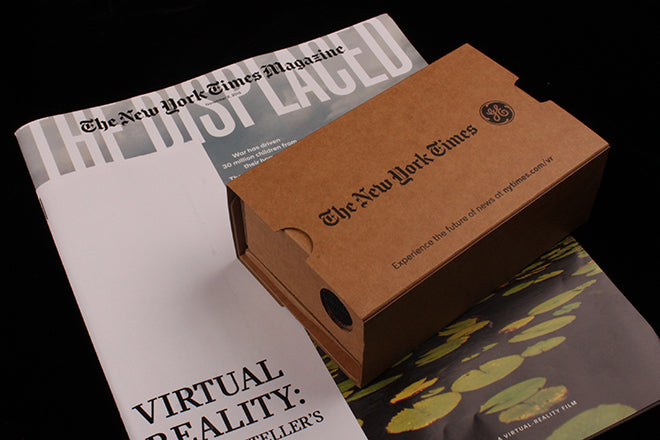
NY Times Magazine VR issue

Last weekend’s New York Times Magazine carried a typically thorough report on displaced children. The stories of three – a tiny representation of the 30m kids across the world that have been forced to leave home against their will – were told one by one, the writing, photography and layout doing simple, bold justice to the power of their testimonies.

We’ve featured other issues of the magazine here recently, and have naturally tended to focus on the flamboyant typographics and beautiful layouts. A designer can have fun with a special travel issue; this one rightly plays down that side of the publication, reflecting the sobreity of the stories through a quieter design. It’s still beautifully put together, of course, and recognisably the NYTimes Mag, but the design volume is turned right down.

Instead, the printed story is embellished by the magazine’s first foray into reporting via virtual reality. A million free Google Cardboard viewers (above) were distributed with the magazine last weekend. The user inserts their smartphone into the holder and can watch a virtual reality film. Downloaded free and accessed via a free app, the film adds a unique layer to the whole Displaced story.

The idea was conceived by magazine editor Jake Silverstein, and produced in co-operation with NY studio Vrse. ‘Our editorial, photo and art teams gave input on the structure and narrative throughout the process,’ explains NYT Mag design director Gail Bichler, ‘The magazine’s art department did the title graphics within the video, but more of our focus was on the infrastructure of putting out the film.’ This included the physical items (the viewer, the packaging) as well as the app and website that house the films. Other senior staff, like photography director Kathy Ryan, were very involved too. ‘This project was a massive effort from The Times as a whole, involving many departments and contributors.’

As a one-off experiment the story works really well; the longform writing and carefully edited photography of the print version are strong and familiar; the film adds another layer to the entire story. Reading the magazine story, you feel empathy and appreciate the seriousness situations presented. Switching to seeing the subjects in the films provides a genuine shudder of reality.

However well-written a piece like this is, it still adapts itself to the familiar context of ‘serious reportage piece.’ The films, all presented in subtitled first person without spoken introduction or commentary (though obviously edited and mediated in other ways) allow the viewer to see the kids as what they are – young people dealing bravely with circumstances beyond their control.

It works really well, and the VR effect is as compelling as ever, adapting readily to a serious story. If there remains an aura of gimmickry to VR, this type of usage should help make it a more mainstream and natural form. The films are refreshingly effect-free; just seeing the three very different environments and climates the three subjects live in emphasises the widespread reach of the problem.
‘At the moment these films are very labour-intensive, but the technology is in its infancy. The idea is to add this to our arsenal of storytelling tools,’ says Bichler, ‘We will be launching another film in about a month and a third soon after that.’
I look forward to them, and congratulate the magazine on continuing to experiment in new directions.
nytimes.com/newsgraphics/2015/nytvr


